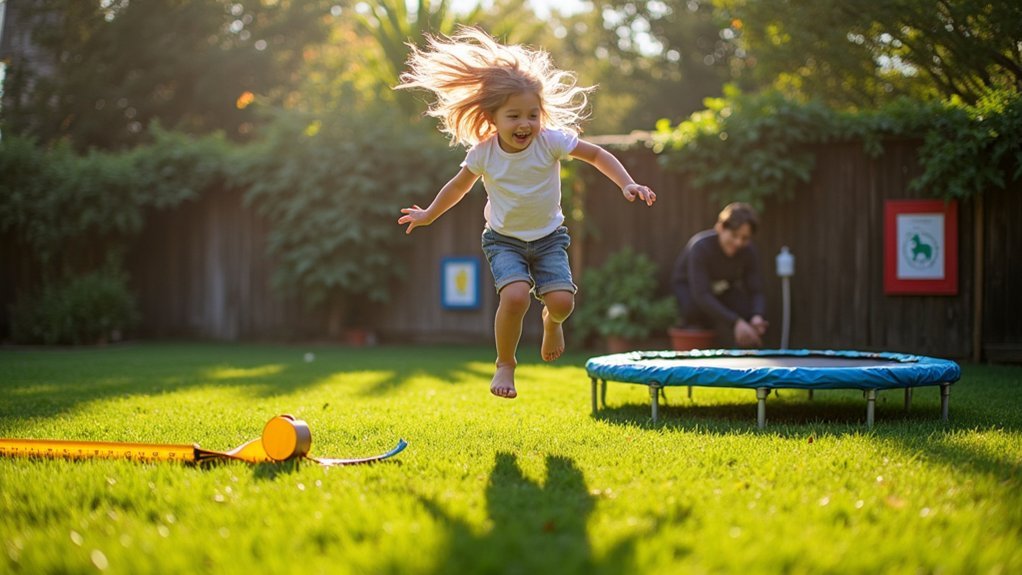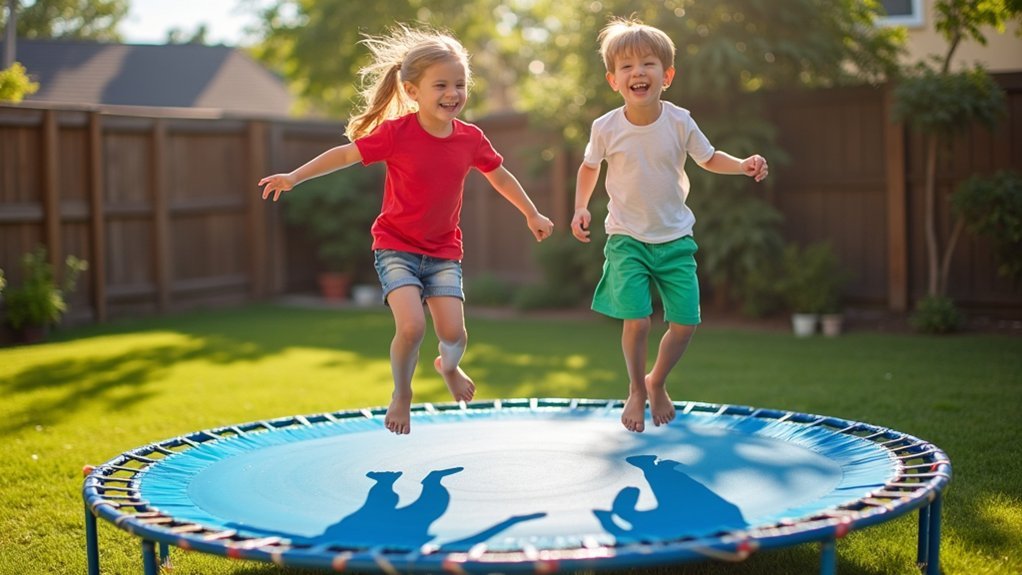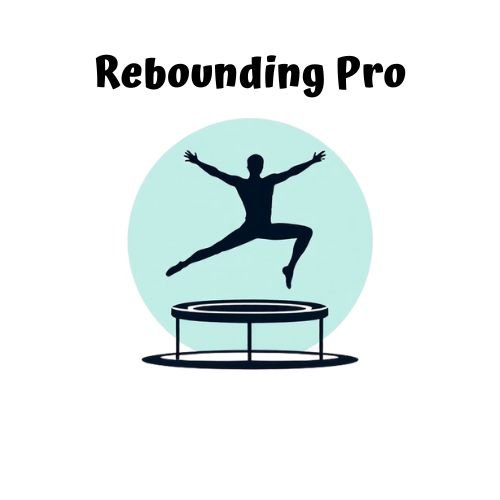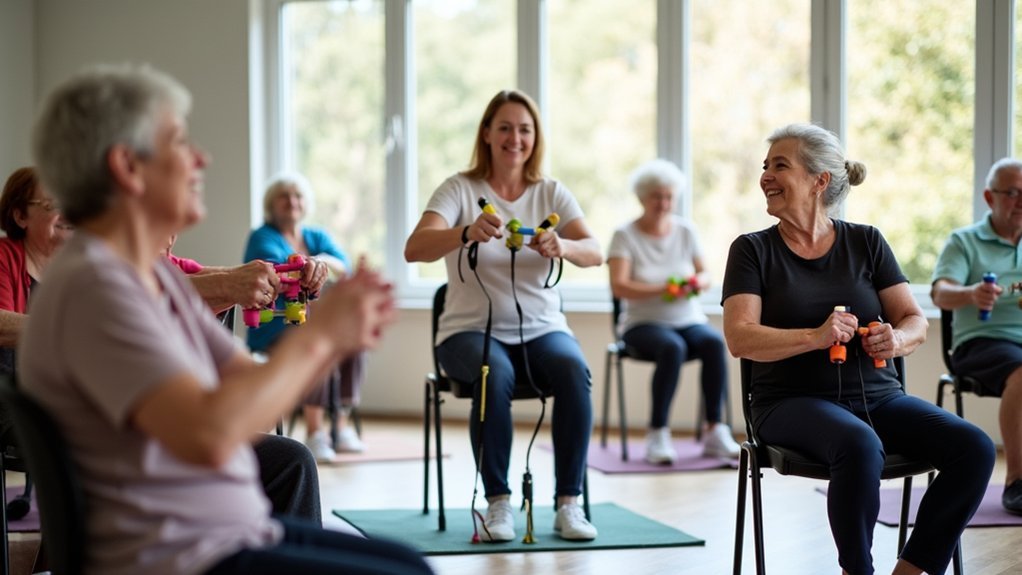Limit trampoline jump heights based on age—6-12 inches for toddlers, 24 inches for kids 5-10, and up to 36 inches for children over 10. Install safety enclosures and provide constant supervision. Teach children to control bounce height with proper technique, like arm extension and knee bending. Use visual markers and height-based games to reinforce boundaries. Watch for signs of overexertion like uncoordinated movements. These height guidelines create a safe environment where fun and fitness thrive together.
Setting Safe Jump Height Limits for Children

While trampolines provide excellent exercise for kids, establishing appropriate jump height limits is vital for their safety. For children aged 5-10, restrict jump height to about 24 inches to prevent injuries. Older children over 10 can safely jump up to 36 inches, depending on their coordination skills.
Always install safety enclosures around your trampoline to protect children from falls when they inevitably exceed safe limits. Constant supervision is essential, as children’s enthusiasm often leads to higher jumps than recommended. Watch for changes in their energy levels and adjust your guidance accordingly.
Regularly inspect your trampoline condition, checking for tears, loose springs, or unstable frames that could compromise safety.
Age-Appropriate Bounce Boundaries for Kids
Because a child’s coordination and physical development differ markedly across age groups, establishing age-appropriate bounce boundaries is crucial for trampoline safety.
For toddlers and young children ages 2-6, limit bounce height to 6-12 inches while they develop basic coordination skills.
As kids grow into the 7-12 age range, you can safely increase maximum heights to 24 inches, allowing more dynamic movement while maintaining safety.
Regardless of age, make sure your trampoline includes proper safety features like padded edges and enclosure nets.
Always provide direct supervision during trampoline workouts, especially when children are jumping at higher elevations.
Teaching kids about their age-appropriate boundaries helps them understand their limitations and promotes responsible jumping habits.
These guidelines create an environment where children can enjoy the benefits of trampoline exercise while minimizing injury risks.
Measuring the Right Trampoline Clearance

To guarantee your child’s safety during trampoline workouts, you’ll need at least 24 feet of vertical clearance above the jumping surface and 3 feet of horizontal space around the perimeter.
Use a tape measure to verify the distance from the trampoline mat to any overhead obstacles like tree branches or roof overhangs.
Remember to reassess these clearance measurements regularly as your kids grow taller and their jumping skills improve.
Overhead Space Requirements
Safe jumping requires adequate overhead clearance for your trampoline setup. To prevent injuries, you’ll need at least 24 inches of overhead space above your trampoline’s highest point. For outdoor setups, maintain minimum 8 feet of vertical space from the trampoline surface to any overhead structures like trees or power lines.
| Location | Minimum Clearance | Safety Considerations |
|---|---|---|
| Indoor | 3 feet above jumper | Check ceiling height |
| Outdoor | 8 feet vertical space | Avoid power lines |
| Enclosure | 24+ inches above net | Account for full jump height |
| Basement | 3+ feet clearance | Measure from tallest user |
| Garage | Check for fixtures | Remove hanging hazards |
Remember to include the total height of any safety enclosure when calculating required clearance. Regularly check your jumping area for new overhead hazards that could impact safe use of your trampoline.
Safety Zone Measurements
Creating a secure jumping environment extends beyond overhead spaces to the area surrounding your trampoline. Establish a safety zone of at least 6 feet in all directions from the trampoline’s edge to prevent collisions with obstacles. This buffer area is essential for preventing injuries during dismounts or falls.
Remember that vertical space requirements remain important—maintain a minimum of 24 inches of clearance above the jumping surface to protect against head injuries. Your trampoline’s platform height shouldn’t exceed 36 inches for children, as higher platforms increase injury risks.
For outdoor setups, guarantee the ground is level and add fall padding around the perimeter. Install protective mats to cushion potential falls.
Regularly check that all safety features remain intact and effective, especially enclosures that define your safety zone boundaries.
Visual Markers for Maximum Height Safety
While children naturally want to jump as high as possible on trampolines, establishing clear visual markers creates essential safety boundaries. Use brightly colored tape or cones at appropriate heights to help your child understand their jumping limits. These visual indicators should correspond to your child’s age and skill level, preventing dangerous jumps that could result in injury.
Before each jumping session, remind your children about the importance of staying below the markers. Make it a simple rule: “Fun happens below the line!”
As your child grows and develops stronger jumping abilities, regularly reassess and adjust these boundaries. This evolving system guarantees continued safety while still allowing them to enjoy their trampoline workout. The visual nature of these markers makes safety rules concrete rather than abstract for energetic kids.
Teaching Children to Control Their Bounce Height

To teach your child proper bounce height control, start with gentle, low bounces that build confidence while developing movement mastery.
Encourage them to extend their arms for better balance and bend their knees upon landing to absorb impact and naturally limit jump height.
Reinforce good habits by establishing visual boundaries and consistently reminding them to focus on proper posture rather than achieving maximum height.
Height Control Essentials
When children first experience the joy of a trampoline, they often bounce as high as possible without considering safety. Teaching proper height boundaries is vital for preventing injuries during their workout sessions.
Encourage your kids to maintain a low bounce by keeping their feet close to the trampoline surface. Use visual references like “bounce only as high as a soccer ball” to help them understand appropriate bounce height. Remind them to land with knees bent to absorb impact and guarantee a safe landing every time.
Create designated bouncing zones on the trampoline and make certain children understand where these boundaries are. Always provide supervision during trampoline activities, giving immediate feedback on their technique.
This constant guidance helps reinforce height control habits that keep their workouts both fun and safe.
Safety-First Bounce Practices
Although trampolines provide excellent exercise, they require specific safety protocols to prevent injuries. Teaching your child to maintain a controlled bounce height of just 1-2 feet off the surface greatly reduces risk while still delivering fitness benefits.
Guarantee a safety-first approach by implementing clear rules and consistent supervision during every session.
- Demonstrate controlled jumps by having children bend their knees when landing to maintain balance
- Enforce a strict “no flips” policy to prevent dangerous loss of control
- Train children to stay centered on the trampoline, avoiding bounces near the edges
- Practice “stop jumps” where kids can quickly halt their momentum when needed
- Maintain constant adult supervision to monitor bounce height and correct improper techniques immediately
The Role of Adult Supervision in Height Management
Parents who supervise their children during trampoline activities greatly reduce the risk of height-related injuries. When you’re present, you can enforce safety rules about appropriate jumping heights and prevent dangerous stunts that often lead to trampoline injuries.
Research shows children are more likely to follow guidelines when a responsible adult is watching. You should guarantee your child only jumps to heights that allow for safe landings within the trampoline’s designated area.
The American Academy of Pediatrics specifically warns against high jumps and acrobatic maneuvers without proper supervision.
Your consistent presence during trampoline time isn’t just recommended—it’s essential. By actively monitoring jumping heights and setting clear boundaries, you’ll create a safer environment where your children can enjoy the physical benefits of trampolining without unnecessary risks.
Adapting Height Restrictions as Skills Improve
As children gain confidence on the trampoline, you’ll need to thoughtfully adjust your height guidelines to match their developing abilities. Start with conservative height restrictions, then gradually allow higher jumps as their balance and stability improve. This progressive approach builds both skills and safety awareness.
- Begin with basic moves like controlled bouncing and jumping jacks that keep feet close to the surface.
- Watch for mastery of fundamental techniques before permitting higher jumps.
- Increase height allowances incrementally—perhaps just a few inches at a time.
- Schedule regular skill assessments to determine when restrictions can be safely relaxed.
- Celebrate progress with new challenges that match their improved coordination and control.
Remember that even as skills improve, maintaining boundaries around maximum jump height remains essential for injury prevention.
Physical Signs That Jumping Is Too High
Recognizing when a child’s trampoline jumps exceed safe heights requires careful observation of their body language and movement patterns.
Watch for jumps consistently higher than waist level, which often indicates overexertion that necessitates height adjustment.
Pay attention to their landing technique—children should maintain balance and land softly with bent knees. If you notice unstable landings or poor form, they’re likely jumping too high for their skill level.
Signs of fatigue like heavy breathing, uncoordinated movements, or diminished proper form signal it’s time for a break or lower jumps.
Also note their emotional state during jumping. A tense posture or fearful expression suggests they’re exceeding their comfort zone.
Regular monitoring of these physical cues helps guarantee your child enjoys safe, appropriate trampoline workouts.
Creating Height-Based Games for Safer Exercise
While ensuring safety on trampolines, you’ll find that turning height restrictions into creative games transforms necessary limits into exciting challenges.
By establishing clear height boundaries and wrapping them in playful activities, you’re teaching kids controlled bouncing techniques while they’re having fun.
Safety becomes fun when boundaries transform into games, teaching control through playful challenges rather than restrictions.
- Create “Jumping to the Rainbow” where children reach for colored markers at safe heights appropriate for their age
- Implement “Height Challenge” competitions where kids take turns reaching designated safe jumping heights
- Use visual aids like foam blocks or ribbons to clearly mark acceptable bouncing levels
- Develop team games where children earn points for maintaining controlled jumps within safe limits
- Design progressive challenges that reward technique and control rather than excessive height
Remember to consistently reinforce safety rules while keeping the atmosphere positive and achievement-focused.
Training Techniques for Controlled Rebounding
Controlled rebounding forms the foundation of safe trampoline workouts for children, enabling them to enjoy the exercise benefits without unnecessary risks. When training kids, emphasize gentle bounces rather than high jumps—this reduces injury potential while maintaining fun.
Establish clear height boundaries, instructing children to keep jumps below waist level. This rule helps them maintain control while minimizing joint impact. Incorporate balance drills that develop coordination and stability; try single-leg stands or controlled knee lifts while maintaining position.
Choose a rebounder appropriate for your child’s size—typically 36-48 inches in height works best for most kids. Always conduct supervised workouts, ensuring safety features are intact and that children follow proper techniques.
With consistent guidance, they’ll develop controlled rebounding skills that serve them well.
Frequently Asked Questions
Does Trampoline Help Kids Grow Taller?
No, trampolines don’t directly make your child taller. While they’re great for fitness and posture, your kid’s height is primarily determined by genetics, nutrition, and overall health—not specific exercises like jumping.
What Is 10 Minutes on a Trampoline Equivalent To?
Ten minutes on a trampoline equals about 30 minutes of jogging. You’ll burn 100-150 calories while enjoying a low-impact workout that improves your cardiovascular health and strengthens multiple muscle groups simultaneously.
Why Can’t Kids Under 6 Use a Trampoline?
Children under 6 shouldn’t use trampolines because they lack developed coordination, balance, and bone strength. You’ll find they’re more vulnerable to injuries, and they often can’t understand safety rules that protect them from accidents.
How Old Should a Child Be to Jump on Trampoline?
Children should be at least 6 years old before using a trampoline. You’ll want to wait until they’ve developed proper coordination and balance. Always supervise your child and teach them safety rules while jumping.
In Summary
You’ve now got all the tools to keep your kids safe while they enjoy trampoline workouts. Remember, height boundaries aren’t about limiting fun—they’re about maximizing safety and proper skill development. As you implement these guidelines, you’ll watch your children bounce with confidence and control. Stay consistent with your safety rules, adjust as they grow, and you’ll create a bouncing experience that’s both exhilarating and secure.





Leave a Reply